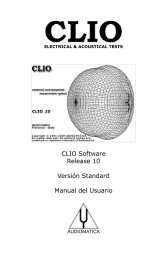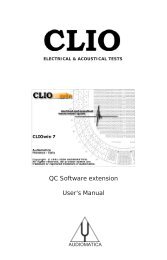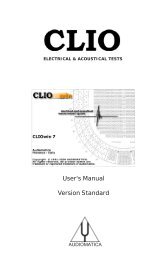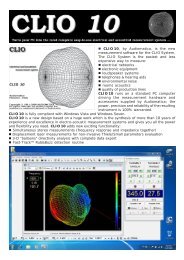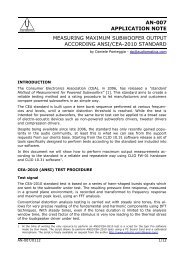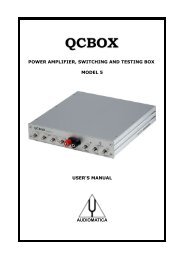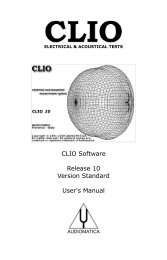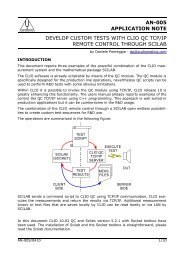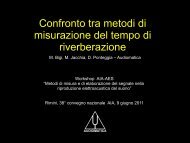CLIOwin 6.5 PCI User's Manual - Audiomatica Srl
CLIOwin 6.5 PCI User's Manual - Audiomatica Srl
CLIOwin 6.5 PCI User's Manual - Audiomatica Srl
Create successful ePaper yourself
Turn your PDF publications into a flip-book with our unique Google optimized e-Paper software.
9.4 FFT AND RTA OPERATION<br />
The FFT and RTA measurements (and also Multi-meter ones, see Chapter 8) differ from<br />
MLS and Sinusoidal ones in the fact that they are interactive, the user has control over<br />
measurement time and generated stimuli. You may obtain from them only answers<br />
about unknown signals, without any care for generating a stimulus; or you may leave<br />
to others this job, like when you measure an audio chain relying on the test signals<br />
contained in a CD-ROM. One effect of this is that, strictly speaking, FFT measurements<br />
may lead to less precise results if compared to other techniques; the possibility of<br />
injecting a synchronous MLS sequence at the beginning of the same audio chain<br />
mentioned before is surely a better approach even if, in the vast majority of cases,<br />
unfeasible.<br />
FFT and RTA power depends not only on the measurements settings themselves but<br />
also on the generated signals.<br />
<strong>CLIOwin</strong> adds the possibility of internal trigger (and relative delay) i.e. triggering with<br />
respect of the generated signal thus obtaining a synchronous capture. Let's see how a<br />
measurement presented in section 11.4 was done; please refer to figures 11.9, 11.10<br />
and 11.11. We have an acoustical measurement of a tweeter, done stimulating it with<br />
a 2kHz 10ms tone burst (see 5.4.2 for details about programming a bursted sinusoid);<br />
the FFT measurement is done in internal trigger; Fig. 11.9 shows the analysis and the<br />
captured time data that clearly show the flight time from the tweeter to the microphone;<br />
Fig. 11.9, even if the analysis is not our final target, show the power of synchronous<br />
acquisition which permits to display the arrival delay of sound to the microphone. To<br />
obtain the desired result, as explained in 11.4, it is necessary to remove the flight time<br />
plus the device settling time; this can be easily accomplished setting the internal trigger<br />
delay, in FFT settings, to 1.5ms; the final result shown is shown in 11.11 and permits<br />
the identification of the device harmonic distortion. To proceed further one could vary<br />
the stimulus amplitude and test the distortion of the tweeter at different amplitudes;<br />
using bursts prevents also the damage of the unit as the overall power delivered to it<br />
rather low and a direct function of the duty cycle of the burst itself.<br />
Other useful signals are noises and multitones. The predefined signal file is the<br />
all4096.sig; you can play it pressing the FILE button from the Multi-meter panel, or<br />
choosing it from the list of signal files. As its name suggests this multitone signal is done<br />
adding 4096 sinusoids of the same amplitude which frequencies exactly fall inside an<br />
FFT frequency bin; for a sampling frequency of 51200Hz a frequency bin in a 4096 points<br />
analysis is a multiple of 12.5Hz; for a sampling frequency of 48000Hz a frequency bin<br />
in a 4096 points analysis is a multiple of 11.71875Hz. This particular signal should be<br />
employed, for maximum performances, when analyzing a system with a 4096 points<br />
FFT; should you change FFT size, you should change stimulus too. Using this signal it<br />
is possible to assess the frequency response in a single FFT acquisition without the need<br />
for any averaging. Among noises we find the pink noise that is required when taking<br />
RTA measurements. <strong>CLIOwin</strong> has several pseudo-random pink noises (like<br />
pink16384.sig) that are filtered versions of an MLS sequence. Use this stimulus when<br />
executing RTA measurements, due to its pseudo random nature permits RTA analysis<br />
that settle in a fraction of time with respect to analysis done with true pink noise. Choose<br />
the file with the name matching the length of the FFT used; for a 16K RTA use the<br />
pink16384.sig signal.<br />
The main application of RTA analysis is in assessing the quality of an audio installation<br />
(from the placement of the speakers in a listening room to the overall sound quality of<br />
a car stereo system). In these case it is often used the pink noise as stimulus. If you<br />
are not using CLIO as the source of such a stimulus be sure to use a good one; you may<br />
80 Chapter 9 - FFT




